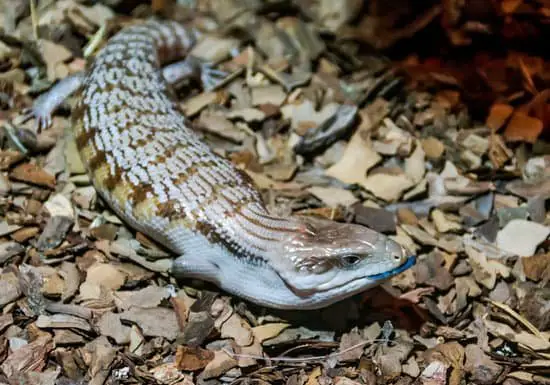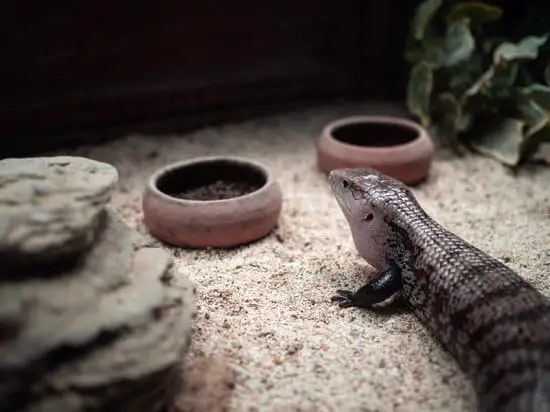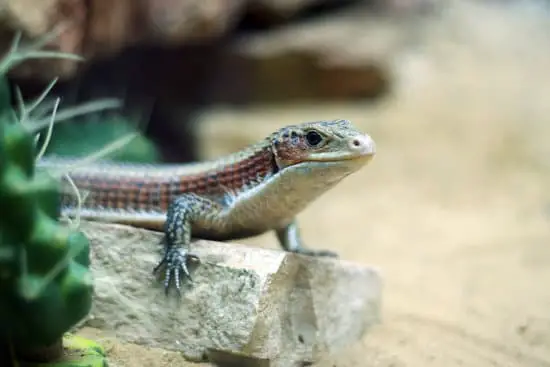Blue tongue skinks are unique reptiles but they are not suitable pets for first-time reptile owners. However, it is quite easy to care for them, so they are a popular pet for reptile lovers. Before you decide to buy a blue tongue skink, you need to first research the cost of getting one.
Generally, the price of blue tongue skinks will depend on several factors like sex, age, morphs, and so on. The average cost of a blue tongue skink is $150, and rare blue tongue skinks can cost up to $5000 or more.
In this article, we will talk about the cost of a blue tongue skink and then list out some tips that you can follow to choose a good healthy skink.
Contents
Cost To Buy Blue Tongue Skink
Just like any other pet, buying a blue tongue skink is usually expensive for first-time owners. This is because you will need to pay for the skink and also set up their new habitat. You can get a common blue tongue skink for up to $250, while rare ones can cost more.
However, the initial cost of setup and supplies can cost you about $500-$700. This is because you will need to buy a tank and set up the tank with substrates, hides, plants, and other accessories before you even bring home the pet.

Choose The Size And Gender Of The Blue Tongue Skink
Unlike numerous lizard species where male and female lizards have different temperaments, both male and female blue tongue skink have similar temperaments. Choosing a male or female blue tongue skink will depend on whether you want to breed your lizard or not.
Furthermore, choosing a young or mature blue tongue skink will also depend on your preferences and needs. You can choose a young blue tongue skink if you want a lizard that you can easily tame and watch as it grows.
Another thing is that there is a higher chance that you will choose a captive-bred lizard when buying a young blue tongue skink. You can also buy an adult blue tongue skink if it is already tame and docile and needs a good place to live.
However, when choosing an adult blue tongue skink, you should ensure it is healthy as well. This is because some sellers may want to sell a sick or aggressive mature wildly caught blue tongue skink for you.
How Much Does a Blue Tongue Skink Cost?
Buying a blue tongue skink is easier as it is commonly available at local pet stores and breeders. The price of a blue tongue skink usually varies based on the morphs you want and where you are buying it.
A common blue tongue skink usually costs around $150-$250. However, rare skink morphs can cost about $5000. Adult blue tongue skinks are usually more costly than babies.
This is because adults will need more care, and the seller will take their time to care for the hatchlings and to provide food and shelter for the lizard.
Factors That Affect Blue Tongue Skink Cost
Several factors can affect the cost of a blue tongue skink, and it can be hard to estimate its exact price without looking at these factors. Some of them are stated below.
Morphs
There are different blue tongue skink morphs available out there, and the type you want will surely affect its price. Common blue tongue skink morphs like the northern blue tongue skink are usually the cheapest.
However, if you want rare blue tongue skink morphs like shingle back or Centralian blue tongue skinks, you should expect to pay over a thousand dollars for them.
Location
Your location can easily affect the price of a blue tongue skink. Since blue tongue skinks are native to Indonesia, Australia, and surrounding areas, blue tongue skink in those areas is usually cheap.
However, it can cost more if you buy from other parts of the world as you will pay for shipping or pay high costs when buying from a local breeder.
Another thing is that you can buy them at a cheap price if living in a big city because there will be several options to choose from. However, people living in rural areas usually have limited options and can pay more when buying their lizards.

Health Of The Lizard
The health of a blue tongue skink can affect its price. A healthy blue tongue skink will surely cost more than an unhealthy one.
Some of the other factors that can affect the price of blue tongue skinks are age, sex, season, etc.
5 Tips To Choose A Good Healthy Skink
One of the things to consider when buying a blue tongue skink is its health. There are several things that you can use to determine whether a skink is healthy or not. Some of them are stated below.
Blue Tongue Skink Should Be Active And Alert
Blue tongue skinks are diurnal reptiles which means they are usually active in the day. A healthy blue tongue skink is active and alert and reacts to the surroundings. They usually move around their tank and will respond to movements with their head or tongue.
Your blue tongue skink may be sick if it suddenly becomes lethargic or stops moving. However, skinks can also be lethargic when shedding, bromating, or ovulating.
Blue Tongue Skink Is Enough Weight
A healthy blue tongue skink does not get underweight. Generally, a blue male skink is usually heavier than the female, but the female has a longer body than the male. A skink can become underweight if it suffers from parasites, infections, and malnutrition.
You can determine whether your skink is underweight if their bones, especially those protruding at the limbs, hips, and back.
Body Should Be Firm, And The Jaw Should Be Strong
A healthy blue tongue skink has a firm body and a strong jaw. A skink may be suffering from metabolic bone disease if it has kinks in the back or tail or if it has a soft and rubbery jaw. This usually occurs because of bad lighting and poor diet.
You can determine that your skink has a rubbery jaw if it has a problem eating or if the jaw is hanging open all the time.
Clean And Healthy Skin
A healthy blue tongue skink has clean and healthy skin. They don’t have lumps on or under their skin, and the presence of this can indicate that your skinks have cysts and tumors. You can also check if your skinks have their five toes, are in good shape, and are unbroken.
Healthy skin has a clear eye without any cloudiness. Furthermore, a blue tongue skink should not have retained shed, scars, or wounds on their skin.
Another thing you should be on the lookout for is whether your skink does not have mites or ticks on its skin. This usually indicates that the skink you buy is a wild-caught animal.

Observe How The Breeder Takes Care Of The Blue Tongue Skink
Before you decide to buy a blue tongue skink from a breeder, you should also check how the breeder takes care of it. You can first check the tank where the breeder keeps the skink. The tank should be clean, large, and with food bowls and other accessories needed by the skink.
However, if a seller uses a small dirty tank to keep the skink, it shows that the seller does not care about the lizards. This is because a small and dirty tank can lead to injuries, skin damage, and several other infections.
Where Should You Buy Or Adopt A Blue Tongue Skink?
You can buy a blue tongue skink from several places such as online, reptile expos, pet stores, or breeders. However, there are several things to consider before buying your blue tongue skink from each source. Some of them are stated below.
Pet Store
You can buy blue tongue skinks from a pet store close to you. It is best to buy a blue tongue skink from local family-owned pet shops that breed blue tongue skink and know how to care about them.
However, buying a skink from a large pet store may not be the best idea because many pet store employees may not know much about the origin of the skink.
You will need to be extra careful when buying blue tongue skinks at pet stores. You should also perform a health check on the pet, check the tank they house the pet and then ask questions when necessary.
This is because there are some instances where the store cannot accommodate the pet properly and can house two or more skinks together.
Reptile Expos
It is easier to find captive-bred and well-cared blue tongue skinks at a reptile expo. When you decide to buy a blue tongue skink from a reptile expo, you can first research to find a reputable reptile seller that will be available at the reptile expo.
However, there may be bad sellers at the reptile expos as well, and they may try to hide the truth from you. Always ensure you ask questions and examine the blue tongue skink very well before buying. You should also check the housing to check if there are heat sources there.
This is because some sellers may not use heat lamps to keep the skink inactive to make it look docile and calmer.
Online
You will find a wide range of sellers that may want to sell blue tongue skinks to you online. You can find sellers through classified ads, expert breeders with dedicated websites, or dealer websites with several ads from different breeders.
When choosing a potential breeder to buy your skink, you should first research and check their reviews. You should also ask questions and request pictures of the blue tongue skink before buying.
Rescue or Shelter
You are going to find several shelters or rescues where you can buy a blue tongue skink. Skinks are available at a rescue or shelter because some owners cannot take care of their pets anymore. However, if the previous owner of the skink was good, it would be in good shape.
The only drawback when buying skink from a rescue or shelter is that some shelters may not take proper care of the skink, which can cause health and tameness issues. Another thing is that some shelters may want to sell a wildly caught or sick skink to you.
Buying blue tongue skink from a shelter is usually cheap, and when a shelter tries to sell one for you at $50, 100, or 200, then it may be a scam. You should try to ask questions and perform a health check before you decide to buy the skink.
Last Sentences
Blue tongue skinks are quite expensive pets to buy upfront. They usually cost around $150-$5000 based on their morphs and age. Furthermore, the initial cost for setting up their enclosure can also cost around $500-$700.
It is also important to buy everything the blue tongue skinks will need before buying the skink itself. However, caring for a blue tongue skink is a rewarding experience, and maintenance costs are quite cheaper than most conventional pets.
